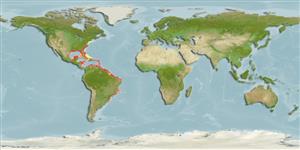Common names from other countries
Environment: milieu / climate zone / depth range / distribution range
Ecologia
marinhas; Água doce; estuarina demersal; intervalo de profundidade 0 - 75 m (Ref. 5217). Tropical; 26°C - 29°C (Ref. 36880); 41°N - 33°S
Western Atlantic: New Jersey, USA to the Antilles and Brazil.
Tamanho / Peso / Idade
Maturity: Lm ? range ? - ? cm
Max length : 21.0 cm TL macho/indeterminado; (Ref. 122735); common length : 15.0 cm TL macho/indeterminado; (Ref. 5217); peso máx. Publicado: 99.40 g (Ref. 122735)
Espinhos dorsais (total): 0; Raios dorsais moles (total): 74-84; Espinhos anais 0; Raios anais moles: 52 - 63
Occurs in shallow muddy bottoms from the coastline to 75 m depth; also in brackish estuaries and hypersaline lagoons (Ref. 5217). Inhabit mainly coastal waters and tidelands, but abundant in waters very near the sea to a few meters elevation with wholly freshwater ichthyofauna (Ref. 36880). Feeds mainly on zooplankton and zoobenthos (Ref. 13196). Taken with beach nets (Ref. 5217).
Distinct pairing (Ref. 205). Oviparous (Ref. 101737). Females produce numerous eggs in multiple spawnings during a prolonged spawning period (Ref. 101737).
Robins, C.R. and G.C. Ray, 1986. A field guide to Atlantic coast fishes of North America. Houghton Mifflin Company, Boston, U.S.A. 354 p. (Ref. 7251)
Categoria na Lista Vermelha da IUCN (Ref. 130435)
CITES (Ref. 128078)
Not Evaluated
Ameaça para o homem
Harmless
Utilização humana
Pescarias: pouco comercial
Mais informação
ReferênciasAquaculturaPerfil para aquaculturaEstirpesGenéticaElectrophoresesHereditariedadeDoençasProcessamentoMass conversion
Ferramentas
Relatórios especiais
Descarregue XML
Fontes da internet
Estimates based on models
Preferred temperature (Ref.
115969): 22.5 - 28, mean 25.5 (based on 608 cells).
Phylogenetic diversity index (Ref.
82804): PD
50 = 0.5000 [Uniqueness, from 0.5 = low to 2.0 = high].
Bayesian length-weight: a=0.00631 (0.00505 - 0.00789), b=3.12 (3.07 - 3.17), in cm Total Length, based on LWR estimates for this species (Ref.
93245).
Nível Trófico (Ref.
69278): 3.6 ±0.58 se; based on food items.
Resiliência (Ref.
120179): Elevada, tempo mínimo de duplicação da população menor que 15 meses (K=0.42; Fec=6,009 (batch fecundity)).
Fishing Vulnerability (Ref.
59153): Low to moderate vulnerability (28 of 100).
